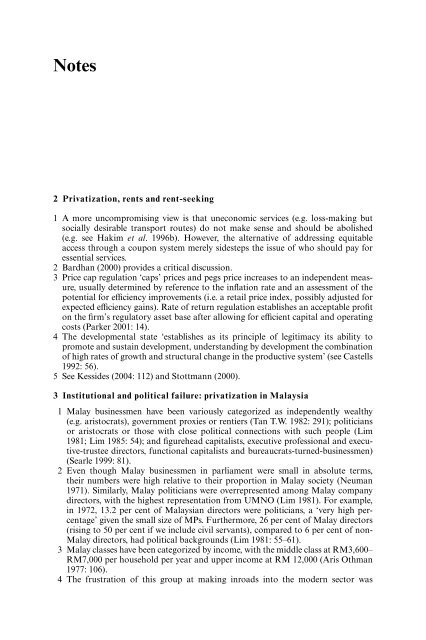PRIVATIZATION Privatization in Malaysia, Regulation, rent-seeking and policy failure
PRIVATIZATION Privatization in Malaysia, Regulation, rent-seeking and policy failure
PRIVATIZATION Privatization in Malaysia, Regulation, rent-seeking and policy failure
Create successful ePaper yourself
Turn your PDF publications into a flip-book with our unique Google optimized e-Paper software.
Notes2 <strong>Privatization</strong>, <strong>rent</strong>s <strong>and</strong> <strong>rent</strong>-seek<strong>in</strong>g1 A more uncompromis<strong>in</strong>g view is that uneconomic services (e.g. loss-mak<strong>in</strong>g butsocially desirable transport routes) do not make sense <strong>and</strong> should be abolished(e.g. see Hakim et al. 1996b). However, the alternative of address<strong>in</strong>g equitableaccess through a coupon system merely sidesteps the issue of who should pay foressential services.2 Bardhan (2000) provides a critical discussion.3 Price cap regulation ‘caps’ prices <strong>and</strong> pegs price <strong>in</strong>creases to an <strong>in</strong>dependent measure,usually determ<strong>in</strong>ed by reference to the <strong>in</strong>flation rate <strong>and</strong> an assessment of thepotential for efficiency improvements (i.e. a retail price <strong>in</strong>dex, possibly adjusted forexpected efficiency ga<strong>in</strong>s). Rate of return regulation establishes an acceptable profiton the firm’s regulatory asset base after allow<strong>in</strong>g for efficient capital <strong>and</strong> operat<strong>in</strong>gcosts (Parker 2001: 14).4 The developmental state ‘establishes as its pr<strong>in</strong>ciple of legitimacy its ability topromote <strong>and</strong> susta<strong>in</strong> development, underst<strong>and</strong><strong>in</strong>g by development the comb<strong>in</strong>ationof high rates of growth <strong>and</strong> structural change <strong>in</strong> the productive system’ (see Castells1992: 56).5 See Kessides (2004: 112) <strong>and</strong> Stottmann (2000).3 Institutional <strong>and</strong> political <strong>failure</strong>: privatization <strong>in</strong> <strong>Malaysia</strong>1 Malay bus<strong>in</strong>essmen have been variously categorized as <strong>in</strong>dependently wealthy(e.g. aristocrats), government proxies or <strong>rent</strong>iers (Tan T.W. 1982: 291); politiciansor aristocrats or those with close political connections with such people (Lim1981; Lim 1985: 54); <strong>and</strong> figurehead capitalists, executive professional <strong>and</strong> executive-trusteedirectors, functional capitalists <strong>and</strong> bureaucrats-turned-bus<strong>in</strong>essmen)(Searle 1999: 81).2 Even though Malay bus<strong>in</strong>essmen <strong>in</strong> parliament were small <strong>in</strong> absolute terms,their numbers were high relative to their proportion <strong>in</strong> Malay society (Neuman1971). Similarly, Malay politicians were overrepresented among Malay companydirectors, with the highest representation from UMNO (Lim 1981). For example,<strong>in</strong> 1972, 13.2 per cent of <strong>Malaysia</strong>n directors were politicians, a ‘very high percentage’given the small size of MPs. Furthermore, 26 per cent of Malay directors(ris<strong>in</strong>g to 50 per cent if we <strong>in</strong>clude civil servants), compared to 6 per cent of non-Malay directors, had political backgrounds (Lim 1981: 55–61).3 Malay classes have been categorized by <strong>in</strong>come, with the middle class at RM3,600–RM7,000 per household per year <strong>and</strong> upper <strong>in</strong>come at RM 12,000 (Aris Othman1977: 106).4 The frustration of this group at mak<strong>in</strong>g <strong>in</strong>roads <strong>in</strong>to the modern sector was


